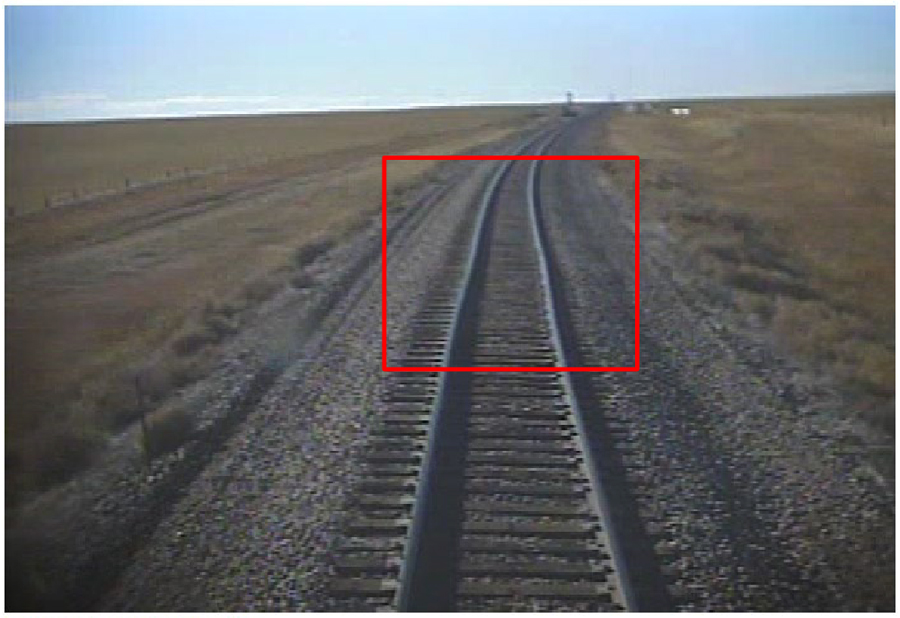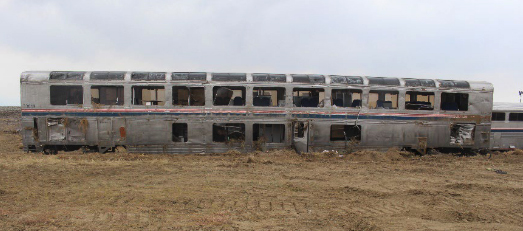
WASHINGTON — Amtrak’s Empire Builder ran through a track misalignment in a curve — distinctly visible in a still from the lead locomotive’s onboard camera — just before its September 2021 derailment in Joplin, Mont., according to information contained in more than 3,100 pages of documents released Tuesday by the National Transportation Safety Board.
The documents form the public docket for the investigation of the Sept. 25, 2021, accident that killed three people and injured 49 others. That docket includes almost 800 pages of interviews with passengers, and more than 300 pages with the train’s crew, along with technical documents on track, equipment, signals, and other aspects of the crash.
The NTSB has yet to complete its final accident report, which will indicate the cause, and cautions in a press release that “no conclusions about how or why the derailment happened should be drawn from the information within the docket. The NTSB will issue a final report at a later date that will include analysis, findings, recommendations, and probable cause determinations related to the derailment.”
However, information about the track defect appears throughout reports included in the docket.
A report from the investigation’s operations group notes that the misalignment in question was visible in a review of video from two freight trains that passed through the location prior to the Empire Builder. The group then reviewed the video from the Empire Builder “approaching the area of the track deviation and when it became visible, it was apparent that the defect had gotten worse. While passing over the area, Amtrak No. 7 shook laterally to the right (north), then left (south), then right again. The train began to slow and eventually stop.”
A report on the Amtrak locomotive’s in-cab video shows that just 15 seconds after the train passed over the misaligned track, the train’s brakes were in emergency; 14 seconds later, it had come to a stop.

Another document, by the investigation’s human performance group, reports that neither crew of the preceding freight trains “noticed the misalignment or detected any unusual train movements while operating over the track defect.” The Amtrak engineer did also not see the misalignment, the report notes, while investigators, “who watched the video and were focused primarily on detecting the track deviation, were able to first see the misalignment only a couple seconds before the trains had traveled over it.”
In an interview conducted by investigators two day after the derailment, the train’s engineer said he had just sounded his horn for a private grade crossing, checked a signal, and checked his speed. “Once I did that, I looked back up,” he said. “I felt a big jerk to the right and then another jerk to the left, and then another jerk to the right. And then the accordion action started. Then the train went into emergency.”
Other information in the docket includes a crashworthiness assessment of the train’s Superliner equipment, which breaks down where injuries occurred. It reports that four passengers were ejected from the train’s lounge car, while two others are believed to have been in the vestibule area between the lounge and a trailing coach at the time of the accident and were likely ejected when the cars uncoupled. Those two and one of the other passengers ejected accounted for the three fatalities.
— Updated at 7 a.m. to include comments from engineer’s interview.














The height of current Amtrak cars contributes to instability when rocking side to side whereas cars with less height are not near as unstable.
The photo indicates a sun kink in the welded rail which can expand and contract in various temperature swings. Railroads often issue heat order speed restrictions and increase track patrols in especially hot weather. I do not know what the temperature conditions were the day of this derailment, but the NTSB appears to be concentrating on the condition of the track. As a train dispatcher I was often told by maintenance of way officials to issue temporary speed restrictions in very hot temperatures. I am retired now, but as I recall speeds were lowered to 30 mph during the day and then brought back to normal track speed at night.
Was there a comment after the incident that mentioned that the cross ties at locations were near replacement time.?
Lets consult my Penn Central Employee Time Table #3, Sunday April 27th 1969 and see what it says about speeds on the PC main from Detroit to Chicago….Passenger Trains, Town Line to Jackson Track #1 and #2..70 MPH. From Jackson to CP150, both tracks 60MPH. CP150 to CP176 Single track 60MPH. CP176 to CP 200, both tracks 60MPH. CP200 to PO (Porter) 60MPH. So going 90? I DON’T THINK SO.
I rode the National Limited from 1973-1975. I would wake up in the middle of the night when the train was at station stops in Columbus and Dayton and the lean was very noticeable.
I can’t do the math, but I would think that a Superliner, with its higher center of gravity, would be more prone to derail and topple over from a sudden lurch at speed than conventional low-level equipment.
Guys, the track speed limit for PC passenger was 79 mph back on the late 60’s early 70’s. I was in PC engine service at that time.
Regarding wobbling cars on bad track, if you’d ever sat on the left side of the engine while meeting a piggyback train at speed you’d wonder why you didn’t go completely grey by the age of 25.
Which is why both the fireman and head end brakeman would get off their chairs and stand behind the engineer.
That really shouldn’t have lead to the cause of the derailment, so why the NTSB has it sprinkled throughout the report is beyond me. The description of the trains movement sounds no different to how the Wolverine rode over the PC/NYC track between Chicago and Detroit in 1968/69 when I rode the Wolverine at 90 mph(and the lunch time soup kept sloshing out of the bowl, I think I got 2 spoonfulls, the rest was on the table).
GERALD — Track speed on the Michigan trains was more like 59 or 69 in those days, if at the speed limit. A few years after the date you cited, a group of us were trackside at Chelsea, Michigan, about twenty miles west of Ann Arbor. A PCRR freight rolled by. It was so wobbly we ran from the tracks fearing it was to fall on top of us. (We were in Chelsea painting the depot which would be used for the daily Detroit to Jackson local, which ran for a few years.)
While I can’t verify your Michigan story, what you say was all too true for Amtrak trains on the ICRR corridor Chicago to Champaign. Those trains actually did run at 90 mph, on track as bad as PCRR in Michigan.
Leave a piece of silverware in the bowl. It will damp the sloshing induced by the car rocking.